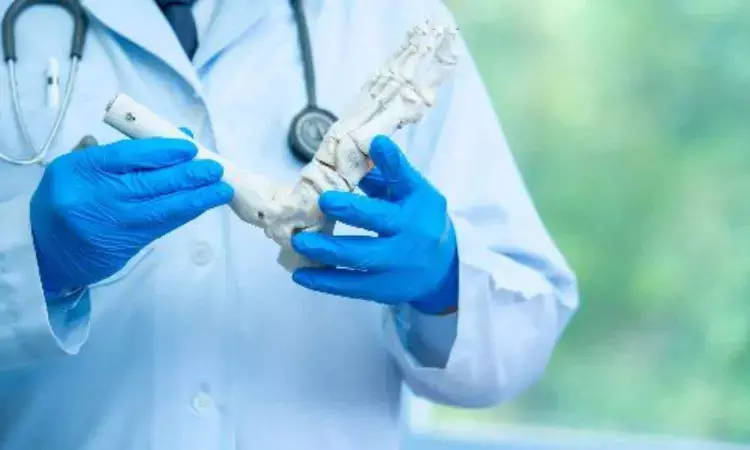- Home
- Medical news & Guidelines
- Anesthesiology
- Cardiology and CTVS
- Critical Care
- Dentistry
- Dermatology
- Diabetes and Endocrinology
- ENT
- Gastroenterology
- Medicine
- Nephrology
- Neurology
- Obstretics-Gynaecology
- Oncology
- Ophthalmology
- Orthopaedics
- Pediatrics-Neonatology
- Psychiatry
- Pulmonology
- Radiology
- Surgery
- Urology
- Laboratory Medicine
- Diet
- Nursing
- Paramedical
- Physiotherapy
- Health news
- Fact Check
- Bone Health Fact Check
- Brain Health Fact Check
- Cancer Related Fact Check
- Child Care Fact Check
- Dental and oral health fact check
- Diabetes and metabolic health fact check
- Diet and Nutrition Fact Check
- Eye and ENT Care Fact Check
- Fitness fact check
- Gut health fact check
- Heart health fact check
- Kidney health fact check
- Medical education fact check
- Men's health fact check
- Respiratory fact check
- Skin and hair care fact check
- Vaccine and Immunization fact check
- Women's health fact check
- AYUSH
- State News
- Andaman and Nicobar Islands
- Andhra Pradesh
- Arunachal Pradesh
- Assam
- Bihar
- Chandigarh
- Chattisgarh
- Dadra and Nagar Haveli
- Daman and Diu
- Delhi
- Goa
- Gujarat
- Haryana
- Himachal Pradesh
- Jammu & Kashmir
- Jharkhand
- Karnataka
- Kerala
- Ladakh
- Lakshadweep
- Madhya Pradesh
- Maharashtra
- Manipur
- Meghalaya
- Mizoram
- Nagaland
- Odisha
- Puducherry
- Punjab
- Rajasthan
- Sikkim
- Tamil Nadu
- Telangana
- Tripura
- Uttar Pradesh
- Uttrakhand
- West Bengal
- Medical Education
- Industry
Combined Osteotomy Technique Restores Wrist Function in distal radius malunions as Graft free alternative: Study

A new study published in the journal of Hand Surgery & Rehabilitation showed that combined radial closing-wedge osteotomy and ulnar shortening osteotomy effectively improve wrist function in distal radius malunions, offering a graft-free alternative to traditional opening-wedge osteotomies.
When a distal radius malunion occurs in a younger patient (less than 45 years old) or occasionally in an older, active patient with strong bone mineralization, an opening wedge osteotomy is the preferred treatment. Without requiring a separate procedure for the distal ulna, iliac bone grafting offers the chance to simultaneously repair distal radioulnar and ulnocarpal malalignment and function. The patients with osteopenia have seldom been recommended for surgery because of the possibility of fixation failure and subsequent malunion.
Posner and Ambrose, on the other hand, support radial closure wedge osteotomy in order to avoid the need for a bone transplant. Due to its less demanding physical requirements, this therapy is particularly well-suited for professionals, retirees, and patients with nondominant extremities. It is also beneficial for elderly and osteopenia patients.
Thus, to close the corrective osteotomy and treat the problems of ulnocarpal impingement and arthritis, radial closing wedge osteotomy has been carried out concurrently with ulnar head excision. For individuals with an intact ulnar carpus and triangular fibrocartilage complex, however, the ulnar head excision is too incapacitating. A preferable option would be an ulnar shortening osteotomy, which maintains the integrity of the triangular fibrocartilage complex and the distal radioulnar joint.
Wrist biomechanics are changed by distal radius malunion, which results in discomfort, stiffness, and functional disability. There are several methods for corrective osteotomy. The purpose of this study was to assess the functional results of treating distal radius malunions with a combination radial closing-wedge osteotomy and ulnar shortening osteotomy.
This research looked back at 20 patients who had ulnar shortening osteotomy and radial closing-wedge osteotomy combined for symptomatic distal radius malunions. Analysis was done on radiographic characteristics, grip strength, range of motion, and functional results.
The surgery considerably increased supination (20° to 80°), flexion (40° to 60°), extension (50° to 65°), and grip strength (12kg to 22kg). Ulnar variance correction was accomplished. Complications developed in four patients, three of whom required revision surgery.
Overall, wrist function is successfully restored with a combination of radial closing-wedge osteotomy and ulnar shortening osteotomy, preventing difficulties associated with grafting. For distal radius malunions, this method offers an alternative to opening-wedge osteotomies.
Source:
Walch, A., Pillot, S., Galissard, T., Gazarian, A., & Druel, T. (2025). Combined radial closing-wedge osteotomy and ulnar shortening osteotomy for distal radius malunion. Hand Surgery & Rehabilitation, 102207. https://doi.org/10.1016/j.hansur.2025.102207
Neuroscience Masters graduate
Jacinthlyn Sylvia, a Neuroscience Master's graduate from Chennai has worked extensively in deciphering the neurobiology of cognition and motor control in aging. She also has spread-out exposure to Neurosurgery from her Bachelor’s. She is currently involved in active Neuro-Oncology research. She is an upcoming neuroscientist with a fiery passion for writing. Her news cover at Medical Dialogues feature recent discoveries and updates from the healthcare and biomedical research fields. She can be reached at editorial@medicaldialogues.in
Dr Kamal Kant Kohli-MBBS, DTCD- a chest specialist with more than 30 years of practice and a flair for writing clinical articles, Dr Kamal Kant Kohli joined Medical Dialogues as a Chief Editor of Medical News. Besides writing articles, as an editor, he proofreads and verifies all the medical content published on Medical Dialogues including those coming from journals, studies,medical conferences,guidelines etc. Email: drkohli@medicaldialogues.in. Contact no. 011-43720751


